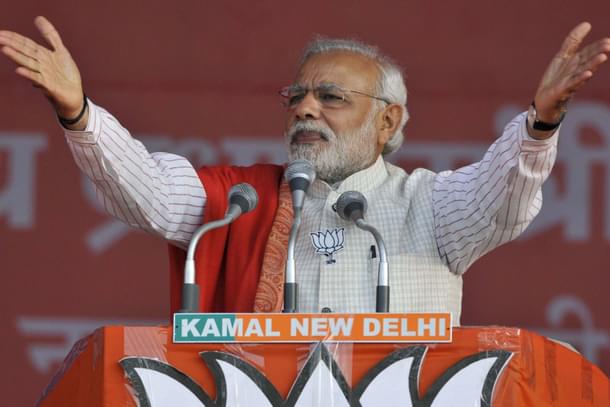Politics
Multi-Phase Polls: Modi’s Advantage Lies In Microcasting Different Messages To Regions Within Each State
R Jagannathan
Mar 12, 2019, 04:37 PM | Updated 04:37 PM IST
Save & read from anywhere!
Bookmark stories for easy access on any device or the Swarajya app.


You can also read this article in Hindi- अनेक चरणों में चुनाव- राज्य के विभिन्न क्षेत्रों में मोदी पहुँचा सकते हैं अलग संदेश
There is a general assumption that the multi-phase voting schedule in several states will benefit the Bharatiya Janata Party (BJP), since it will allow Narendra Modi to plan his election campaign optimally. He can be in different parts of different states at different times, and not have to address each state in big chunks of campaigning. He can narrow-cast his message within each region of each state.
However, if Modi can turn up everywhere and say his piece differently each time, his opponents too have the same advantage. Given that his opposition is fragmented and often restricted to some states, Modi’s appearances in each state will obviously be far lower than the kind of time any regional leader can devote to campaigning.
Where a multi-phase voting schedule will help is in microcasting contradictory voter messages for different regions within a state, when what works in one region does not work in another. There are seven phases of voting in Uttar Pradesh, Bihar and West Bengal, four each in Maharashtra, Madhya Pradesh, Jharkhand and Odisha, and three in Assam and Chhattisgarh.
In 2009, the late Y S Rajasekhara Reddy used the two-phase undivided Andhra Pradesh poll by talking pro-Telangana in the first phase, and then completely reversing his tune in the next, when the polling was in the regions outside Telangana. He won in both regions.
In 2019, Narendra Modi and his party could use this strategy, for example, in Assam, where the Bengali-populated Barak Valley can be given a different message on the Citizenship Amendment Bill as opposed to what he could say in the Brahmaputra Valley, where there is strong opposition to it. The Congress can do the same, by mildly opposing the National Register of Citizens in Barak Valley, and support it in Assamese-dominated regions.
Similarly, in Uttar Pradesh, where the party will have to woo different caste groups with different appeals, Modi will have a chance to consolidate his hold among the upper castes and non-Yadav Other Backward Classes in some phases, and appeal to the Yadav vote in areas where the Bahujan Samaj Party-Samajwadi Party mahagathbandhan may be causing some Yadavs to hesitate to back Mayawati.
In Karnataka, where the BJP is a major contender, the messaging can be soft Hindutva in the coastal regions, and development in the other areas. But in Tamil Nadu, where Modi is a small partner in the All India Anna Dravida Munnetra Kazhagam-led coalition, Modi can focus purely on development and pose as a well-wisher in Delhi who can help the state grow faster.
In the age of hyper-media coverage of politics, and quick dissemination of news over social media platforms like WhatsApp and Twitter, nothing said anywhere remains purely local. But it would be presumptuous to believe that something said in person at a public rally in Varanasi will not have greater impact than what social media brings as contradictory news from elsewhere.
This – the microcasting of contradictory messages that appeal to different voter interests – is the main advantage for parties in multi-phase polling within each state.
But this is an advantage that even the opposition parties can take advantage of. Whether they can actually do it depends on the level of strategic thought that goes into their campaigning. Modi has an advantage only in the sense that his election team is sharper than that of most of his rivals.
Jagannathan is former Editorial Director, Swarajya. He tweets at @TheJaggi.





